The following is a list of prisoner-of-war camps in the Soviet Union during World War II. The Soviet Union had not signed the Geneva convention relative to the Treatment of Prisoners of War in 1929.
The following is a list of prisoner-of-war camps in the Soviet Union during World War II. The Soviet Union had not signed the Geneva convention relative to the Treatment of Prisoners of War in 1929.
On September 19, 1939, Lavrenty Beria (the People's Commissar for Internal Affairs) ordered Pyotr Soprunenko to set up the NKVD Administration for Affairs of Prisoners of War and Internees to manage camps for Polish prisoners. The following camps were established to hold members of the Polish Army:

The Gulag was a system of forced labor camps in the Soviet Union. The word Gulag originally referred only to the division of the Soviet secret police that was in charge of running the forced labor camps from the 1930s to the early 1950s during Joseph Stalin's rule, but in English literature the term is popularly used for the system of forced labor throughout the Soviet era. The abbreviation GULAG (ГУЛАГ) stands for "Гла́вное Управле́ние исправи́тельно-трудовы́х ЛАГере́й", but the full official name of the agency changed several times.
The NKVD prisoner massacres were a series of mass executions of political prisoners carried out by the NKVD, the People's Commissariat for Internal Affairs of the Soviet Union, across Eastern Europe, primarily in Poland, Ukraine, the Baltic states and Bessarabia. After the start of the German invasion of the Soviet Union on June 22, 1941, NKVD troops were supposed to evacuate political prisoners to the interior of the Soviet Union, but the hasty retreat of the Red Army, a lack of transportation and other supplies, and general disregard for legal procedures often led to prisoners being simply executed.

Internal troops, sometimes alternatively translated as interior troops or interior ministry forces, are military or paramilitary, gendarmerie-like law enforcement services, which are found mostly in the post-Soviet states, primarily Russia. Internal troops are subordinated to the interior minister of their respective countries.

The war crimes and crimes against humanity which were perpetrated by the Soviet Union and its armed forces from 1919 to 1991 include acts which were committed by the Red Army as well as acts which were committed by the country's secret police, NKVD, including its Internal Troops. In many cases, these acts were committed upon the orders of the Soviet leaders Vladimir Lenin and Joseph Stalin in pursuance of the early Soviet government's policy of Red Terror. In other instances they were committed without orders by Soviet troops against prisoners of war or civilians of countries that had been in armed conflict with the USSR, or they were committed during partisan warfare.

Sergei Nikiforovich Kruglov was the Minister of Internal Affairs of the Soviet Union from January 1946 to March 1953 and again from June 1953 until February 1956. He held the military rank of Colonel General. He was involved in several brutal actions of the Soviet security forces. These actions occurred in the 1940s and were carried out alongside his comrade-in-arms General Ivan Serov.
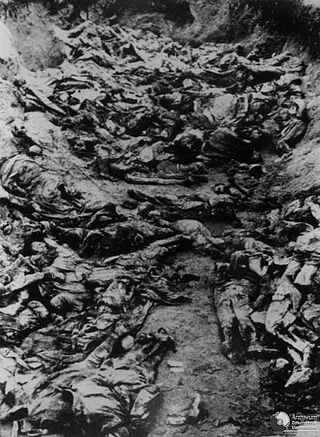
The Katyn massacre was a series of mass executions of nearly 22,000 Polish military officers and intelligentsia prisoners of war carried out by the Soviet Union, specifically the NKVD in April and May 1940. Though the killings also occurred in the Kalinin and Kharkiv prisons and elsewhere, the massacre is named after the Katyn forest, where some of the mass graves were first discovered by German Nazi forces.
Systematic POW labor in the Soviet Union is associated primarily with the outcomes of World War II and covers the period of 1939–1956, from the official formation of the first POW camps, to the repatriation of the last POWs, from the Kwantung Army.
As a result of the Soviet invasion of Poland in 1939, hundreds of thousands of Polish soldiers became prisoners of war. Many of them were executed; 22,000 Polish military personnel and civilians perished in the Katyn massacre alone.
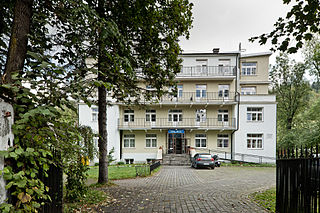
The Gestapo–NKVD conferences were a series of security police meetings organised in late 1939 and early 1940 by Germany and the Soviet Union, following the invasion of Poland in accordance with the Molotov–Ribbentrop Pact. The meetings enabled both parties to pursue specific goals and aims as outlined independently by Hitler and Stalin, with regard to the acquired, formerly Polish territories. The conferences were held by the Gestapo and the NKVD officials in several Polish cities. In spite of their differences on other issues, both Heinrich Himmler and Lavrentiy Beria had similar objectives as far as the fate of pre-war Poland was concerned. The objectives were agreed upon during signing of the German–Soviet Boundary and Friendship Treaty on 28 September 1939.
On May 21, 1945, a unit of the Polish Home Army, led by Colonel Edward Wasilewski, attacked a Soviet NKVD camp located in Rembertów in the eastern outskirts of Warsaw. Hundreds of Polish citizens had been imprisoned there, including members of the Home Army and other members of the underground resistance. Prisoners at the camp were being systematically deported to Siberia. As a result of the attack, all of the Polish political prisoners were freed from the camp by the pro-independence resistance.
Roman Świątkiewicz, pen name Roman Świątek, or Romuald Świątek-Horyń, is a Polish writer, war veteran and World War II amateur historian. He published two controversial books about his personal experiences, Przed czerwonym trybunałem in 1987 in London and The Katyn Forest in 1988 in London under the pseudonym of "Romuald Swiatek". In the books he blamed the Germans for the Katyn massacre. In his second book he also claimed that Gerhard Buhtz, the leader of the German Katyn Commission in 1943 was killed by the Germans in 1944.
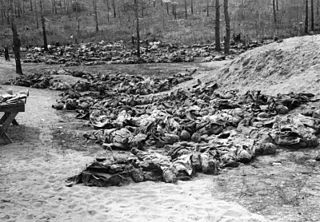
In the aftermath of the German and Soviet invasion of Poland, which took place in September 1939, the territory of Poland was divided in half between Nazi Germany and the Soviet Union. The Soviets had ceased to recognise the Polish state at the start of the invasion. Since 1939 German and Soviet officials coordinated their Poland-related policies and repressive actions. For nearly two years following the invasion, the two occupiers continued to discuss bilateral plans for dealing with the Polish resistance during Gestapo-NKVD Conferences until Germany's Operation Barbarossa against the Soviet Union, in June 1941.
The Main Administration for Affairs of Prisoners of War and Internees was an NKVD department in charge of handling of foreign civilian internees and prisoners of war (POWs) in the Soviet Union during and in the aftermath of World War II (1939–1953).
There were two waves of the Finnish prisoners of war in the Soviet Union during World War II: POWs during the Winter War and the Continuation War.

Approximately three million German prisoners of war were captured by the Soviet Union during World War II, most of them during the great advances of the Red Army in the last year of the war. The POWs were employed as forced labor in the Soviet wartime economy and post-war reconstruction. By 1950 almost all surviving POWs had been released, with the last prisoner returning from the USSR in 1956. According to Soviet records 381,067 German Wehrmacht POWs died in NKVD camps. A commission set up by the West German government found that 3,060,000 German military personnel were taken prisoner by the USSR and that 1,094,250 died in captivity. According to German historian Rüdiger Overmans ca. 3,000,000 POWs were taken by the USSR; he put the "maximum" number of German POW deaths in Soviet hands at 1.0 million. Based on his research, Overmans believes that the deaths of 363,000 POWs in Soviet captivity can be confirmed by the files of Deutsche Dienststelle (WASt), and additionally maintains that "It seems entirely plausible, while not provable, that 700,000 German military personnel listed as missing actually died in Soviet custody."

NKVD special camps were NKVD-run late and post-World War II internment camps in the Soviet-occupied parts of Germany from May 1945 to January 6, 1950. They were set up by the Soviet Military Administration in Germany (SMAD) and run by the Soviet Ministry of Internal Affairs MVD. On 8 August 1948, the camps were made subordinate to the Gulag. Because the camp inmates were permitted no contact with the outside world, the special camps were also known as silence camps.
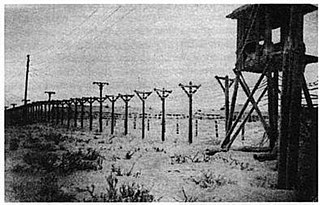
The Vorkuta Corrective Labor Camp, commonly known as Vorkutlag (Воркутлаг), was a major Gulag labor camp in the Soviet Union located in Vorkuta, Komi Autonomous Soviet Socialist Republic, Russian Soviet Federative Socialist Republic from 1932 to 1962.
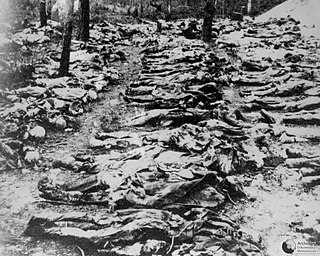
Anti-Katyn is a denialism campaign intended to reduce and obscure the significance of the Katyn massacre of 1940 — where approximately 22,000 Polish officers were murdered by the Soviet NKVD on the orders of Joseph Stalin — by referencing the deaths from disease of thousands of Imperial Russian and Red Army soldiers at Polish internment camps during the Interwar period.

The Monument to the Fallen and Murdered in the East is a monument in Warsaw, Poland which commemorates the victims of the Soviet invasion of Poland during World War II and subsequent repressions. It was unveiled on 17 September 1995, on the 56th anniversary of the Soviet invasion of 1939.

The People's Commissariat for Internal Affairs, abbreviated NKVD, was the interior ministry of the Soviet Union.